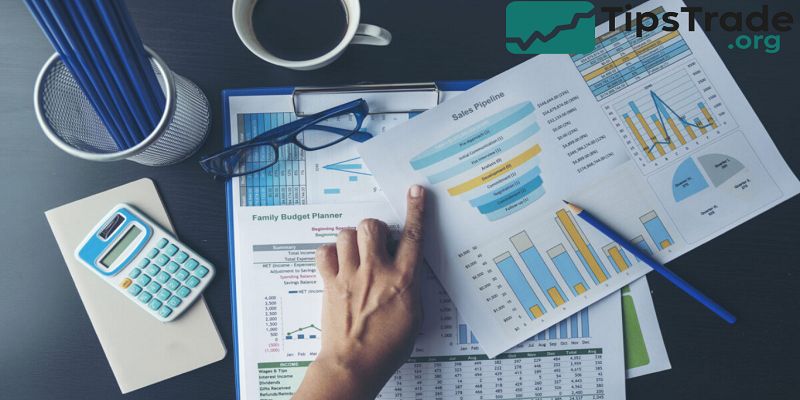Fund reports play a crucial role in helping investors make informed decisions. They provide transparent information about a fund’s performance, holdings, fees, and risk exposures, allowing individuals to evaluate whether a fund aligns with their financial goals. This article breaks down what fund reports include, how to read them, and how investors use them to compare mutual funds, ETFs, and index funds before investing. Visit tipstrade.org and check out the article below for further information
What Are Fund Reports?

Definition of Fund Reports
Fund reports are official documents provided by mutual funds, ETFs, and index funds to disclose essential information to investors.
They summarize how the fund performed during a specific period and include details on holdings, risk metrics, expenses, and any changes in strategy.
For mutual funds, reports are often mandated by regulators like the SEC, ensuring transparency and investor protection.
These documents help investors evaluate whether the fund is managed effectively and whether it remains consistent with its stated goals.
Fund reports are designed to be objective, data-driven, and informative for beginner and advanced investors alike.
Why Fund Reports Matter to Investors
Investors depend on fund reports to validate whether their money is handled responsibly. A fund may market itself with strong historical returns, but only the official performance section shows real numbers compared to benchmarks.
Reports also highlight how much of the return is lost to fees, how volatile the fund is, and whether the manager is sticking to the original strategy.
For example, if a fund claims to be low-risk but carries a high turnover rate, investors can detect inconsistencies.
Fund reports reduce reliance on marketing claims and promote fair, transparent decision-making.
Types of Fund Reports
Fund reports come in several formats. Annual reports provide the most comprehensive insights, including audited financial statements and full commentary from fund managers. Semi-annual reports offer mid-year updates with a briefer performance overview.
Quarterly reports focus on market commentary, performance snapshots, and portfolio changes.
Fact sheets, typically updated monthly, provide a one-page summary of key metrics like top holdings, expense ratio, and risk indicators.
Experienced investors often review fact sheets monthly but rely on annual and semi-annual reports for deeper analysis before making allocation decisions.
Core Components of a Fund Report
Fund Overview & Investment Objective
This section explains the fund’s mission—whether it aims for long-term growth, income generation, capital preservation, or balanced strategies. It also identifies the benchmark index used for comparison, such as the S&P 500 or Bloomberg US Aggregate Bond Index. A clear investment objective helps investors understand the manager’s decision-making framework. For instance, a growth fund targeting high-volatility tech stocks will differ significantly from a conservative bond fund. Reading this section first ensures investors quickly determine whether the fund fits their risk tolerance and financial goals.
Fund Performance Section
Performance data typically includes 1-year, 3-year, 5-year, 10-year, and since-inception returns.
These returns are compared against the benchmark and category average. Long-term investors often prioritize 5- and 10-year returns because they reflect stable management rather than short-term market noise.
For example, a fund that outperforms its benchmark over a decade may indicate consistent and disciplined management. Performance charts, rolling returns, and cumulative returns may also be included.
Investors should look beyond recent surges and focus on long-term behavior to avoid misleading short-term spikes.
Expense Ratio & Cost Breakdown
Fund expenses directly reduce investor returns. The expense ratio includes management fees, administrative costs, and operating expenses.
For actively managed funds, expenses typically range from 0.5% to 1.5%, while index funds often cost less than 0.20%. Some funds also have sales loads or redemption fees.
These costs are fully documented in the report so investors can compare similar funds. As Morningstar research indicates, lower-cost funds statistically outperform higher-cost funds over long periods.
Understanding the expense structure helps investors avoid unnecessary cost drag.
Risk Metrics Explained
Risk metrics provide insight into how much volatility a fund may experience. Standard deviation measures price variability, while beta indicates how the fund moves relative to the market. Sharpe ratio shows how much return is generated per unit of risk. Drawdown reflects the fund’s worst decline from peak to trough. Investors often compare these metrics with those of the benchmark. For instance, a fund with higher returns but a significantly higher standard deviation may not suit risk-averse investors. These metrics are essential for evaluating risk-adjusted performance instead of raw returns.
Portfolio Holdings & Sector Allocation
Fund reports disclose the fund’s top 10 holdings, which typically account for 20–40% of the portfolio.
This transparency reveals where the manager concentrates risk. The report also shows sector allocation, such as technology, healthcare, or financials, along with geographic exposure for global funds.
If a fund claims diversification but has heavy concentration in one sector, investors can detect misalignment.
Reviewing holdings helps investors identify whether the portfolio matches their expected investment strategy.
Manager Commentary & Market Outlook
Manager commentary adds human insight to the raw data. It typically discusses market conditions, investment decisions, and the manager’s expectations for upcoming quarters.
This section helps investors understand whether the manager has a coherent long-term strategy or reacts impulsively to market changes.
As seen in many Vanguard and Fidelity annual reports, strong commentary provides clarity about risks, opportunities, and the reasons behind portfolio adjustments.
This qualitative insight is often as important as the quantitative numbers.
How to Read and Analyze Fund Reports

Start with the Fund Objective & Strategy
- Before diving into numbers, investors should confirm that the fund’s stated objective matches their goals.
- A long-term investor seeking stability might favor bond funds or dividend ETFs, while someone targeting aggressive growth might choose equity funds.
- Understanding the strategy helps investors contextualize performance and risk.
- This step ensures the fund aligns with one’s investment philosophy before analyzing deeper data.
Evaluate the Long-Term Performance
- Investors should focus on the 5- to 10-year performance periods rather than short-term fluctuations.
- Long-term returns reveal whether the manager delivers sustainable results. Comparing performance during bull and bear markets also shows resilience.
- For example, a fund that consistently beats its benchmark during downturns may provide better risk-adjusted performance. Historical consistency is more valuable than temporary outperformance.
Compare Fund Performance with Benchmark Index
- Benchmarks allow investors to measure whether a fund adds value beyond passive alternatives.
- If a fund consistently lags behind its benchmark, investors may question management effectiveness.
- For example, many actively managed funds underperform the S&P 500 after fees. Comparing returns across multiple periods helps investors determine whether performance is skill-based or market-driven.
- This comparison is especially important for expensive active funds.
Examine Fees and Expense Ratio Impact
- Even small expense differences can compound significantly. A fund with a 1.2% expense ratio will erode returns more than a similar fund charging 0.15%.
- The report often includes fee breakdowns to help investors evaluate cost-efficiency. Long-term investors should prioritize lower-cost funds when performance is similar.
- Higher fees may be justifiable only if the fund consistently outperforms its benchmark.
Analyze Risks vs. Rewards
- Risk metrics reveal how volatile the fund is and how much downside investors might face during market turbulence.
- For example, a high-growth equity fund may deliver strong returns but also experience severe drawdowns.
- Understanding these risks helps investors choose funds that match their tolerance level. Risk-adjusted metrics like the Sharpe ratio or beta allow deeper evaluation beyond raw returns.
Review Portfolio Holdings & Turnover
- Holdings reveal whether the fund is diversified or overly concentrated. A high turnover rate—often above 80%—may signal aggressive trading that leads to higher transaction costs.
- Investors should prefer funds whose holdings align with their risk profile and long-term goals.
- Low-cost index funds typically have low turnover and transparent holdings, making them easier to evaluate.
Interpret Manager Commentary
- Manager commentary helps investors understand the reasoning behind decisions such as sector shifts or stock purchases.
- For example, a fund manager may increase exposure to defensive sectors during economic uncertainty.
- This context allows investors to evaluate whether the manager is adapting intelligently or making emotional decisions.
- Commentary also signals whether the manager maintains a consistent strategy.
Identify Red Flags in Fund Reports
- Red flags include rising expense ratios, frequent strategy changes, inconsistent commentary, high turnover, or persistent underperformance.
- If a fund consistently lags behind its benchmark for three or more years, investors may reconsider their position.
- A sharp change in holdings concentration or style drift also indicates instability. Spotting these warning signs early helps investors avoid long-term losses.
Comparing Different Fund Reports

Differences in Reporting Structure
- Mutual funds provide detailed quarterly and annual reports, often with extensive commentary.
- ETFs publish similar information but sometimes rely more on fact sheets due to their passive nature.
- Index funds generally offer the simplest reports, focusing on tracking accuracy rather than strategy.
- Understanding these differences helps investors set expectations and evaluate each fund type appropriately.
Key Metrics for Mutual Funds
- Mutual fund reports emphasize management style, sector decisions, and performance attribution.
- Active funds often justify their decisions through commentary, giving investors insight into strategy execution.
- Investors should pay special attention to turnover rates, which tend to be higher in active funds, impacting costs and tax efficiency.
Key Metrics for ETFs
- ETF reports prioritize tracking error, liquidity, and bid-ask spreads. Since most ETFs are passively managed, their key performance indicator is how closely they track their index.
- Investors also evaluate trading volume and spreads, which affect transaction costs. ETF holdings are typically reported daily, offering high transparency.
Key Metrics for Index Funds
- Index fund reports focus on tracking accuracy, expense ratios, and long-term performance stability.
- Because index funds follow predetermined rules, investors look for low fees and minimal tracking deviation.
- These funds are preferred by cost-conscious investors due to their simplicity and predictable strategy.
How to Use Fund Reports to Choose the Best Fund Type
- Investors can use fund reports to match their goals with the appropriate fund type.
- Active mutual funds may suit those seeking potential outperformance and willing to pay higher fees.
- ETFs benefit investors prioritizing liquidity and flexibility. Index funds appeal to long-term investors who value low costs and simplicity.
- Fund reports help clarify which option aligns best with risk tolerance and investment strategy.
Tools and Sources to Access Reliable Fund Reports

Morningstar Fund Reports
- Morningstar provides detailed fund analyses, ratings, and performance data trusted by millions of investors.
- Its reports include risk assessments, style boxes, and analyst commentary.
- Morningstar’s star rating system helps investors quickly compare funds based on past performance and risk-adjusted returns.
Lipper Ratings & Analysis
- Lipper, part of Refinitiv, evaluates funds based on consistent returns, expense efficiency, and capital preservation.
- Their scoring system helps investors identify funds with reliable performance.
- Lipper reports are commonly used by financial advisors when constructing portfolios.
Fund Company Reports (Vanguard, Fidelity, BlackRock)
- Leading fund companies publish high-quality reports directly on their websites. Vanguard emphasizes low-cost index investing
- Fidelity offers robust insights into active management, and BlackRock provides deeply analytical ETF reports through iShares.
- These sources are extremely reliable for direct fund-level data.
SEC Filings
- The SEC requires mutual funds to publish standardized filings. N-CSR includes shareholder reports, while N-PX lists proxy voting records.
- These documents ensure transparency and accountability.
- Experienced investors often review SEC filings to verify performance data and governance practices.
Free Tools for Investors
- Yahoo Finance and Google Finance allow users to quickly access performance charts, risk metrics, and historical data.
- Many investors use these tools for initial screening before downloading full fund reports.
- Fact sheets provide fast summaries for busy readers.
Conclusion
Fund reports are essential tools for informed decision-making, offering a comprehensive summary of fund performance and management strategies. By carefully analyzing these reports, investors can make better judgments about their investments and anticipate future trends.
